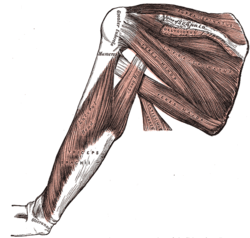Rotator cuff
| Rotator cuff | |
|---|---|

Muscles on the dorsum of the scapula, and the triceps brachii.
|
|

The scapular and circumflex arteries (posterior view).
|
|
|
Anatomical terminology
[]
|
In anatomy, the rotator cuff (sometimes called a "rotator cup", "rotor cuff", or "rotary cup") is a group of muscles and their tendons that act to stabilize the shoulder. The four muscles of the rotator cuff are over half of the seven scapulohumeral muscles. The four muscles are the supraspinatus muscle, the infraspinatus muscle, teres minor muscle, and the subscapularis muscle.
The supraspinatus muscle fans out in a horizontal band to insert on the superior and middle facets of the greater tubercle. The greater tubercle projects as the most lateral structure of the humeral head. Medial to this, in turn, is the lesser tuberosity of the humeral head. The subscapularis muscle origin is divided from the remainder of the rotator cuff origins as it is deep to the scapula.
The four tendons of these muscles converge to form the rotator cuff tendon. These tendinous insertions along with the articular capsule, the coracohumeral ligament, and the glenohumeral ligament complex, blend into a confluent sheet before insertion into the humeral tuberosities. The insertion site of the rotator cuff tendon at the greater tuberosity is often referred to as the footprint. The infraspinatus and teres minor fuse near their musculotendinous junctions, while the supraspinatus and subscapularis tendons join as a sheath that surrounds the biceps tendon at the entrance of the bicipital groove. The supraspinatus is most commonly involved in a rotator cuff tear.
The rotator cuff muscles are important in shoulder movements and in maintaining glenohumeral joint (shoulder joint) stability. These muscles arise from the scapula and connect to the head of the humerus, forming a cuff at the shoulder joint. They hold the head of the humerus in the small and shallow glenoid fossa of the scapula. The glenohumeral joint has been analogously described as a golf ball (head of the humerus) sitting on a golf tee (glenoid fossa).
...
Wikipedia
